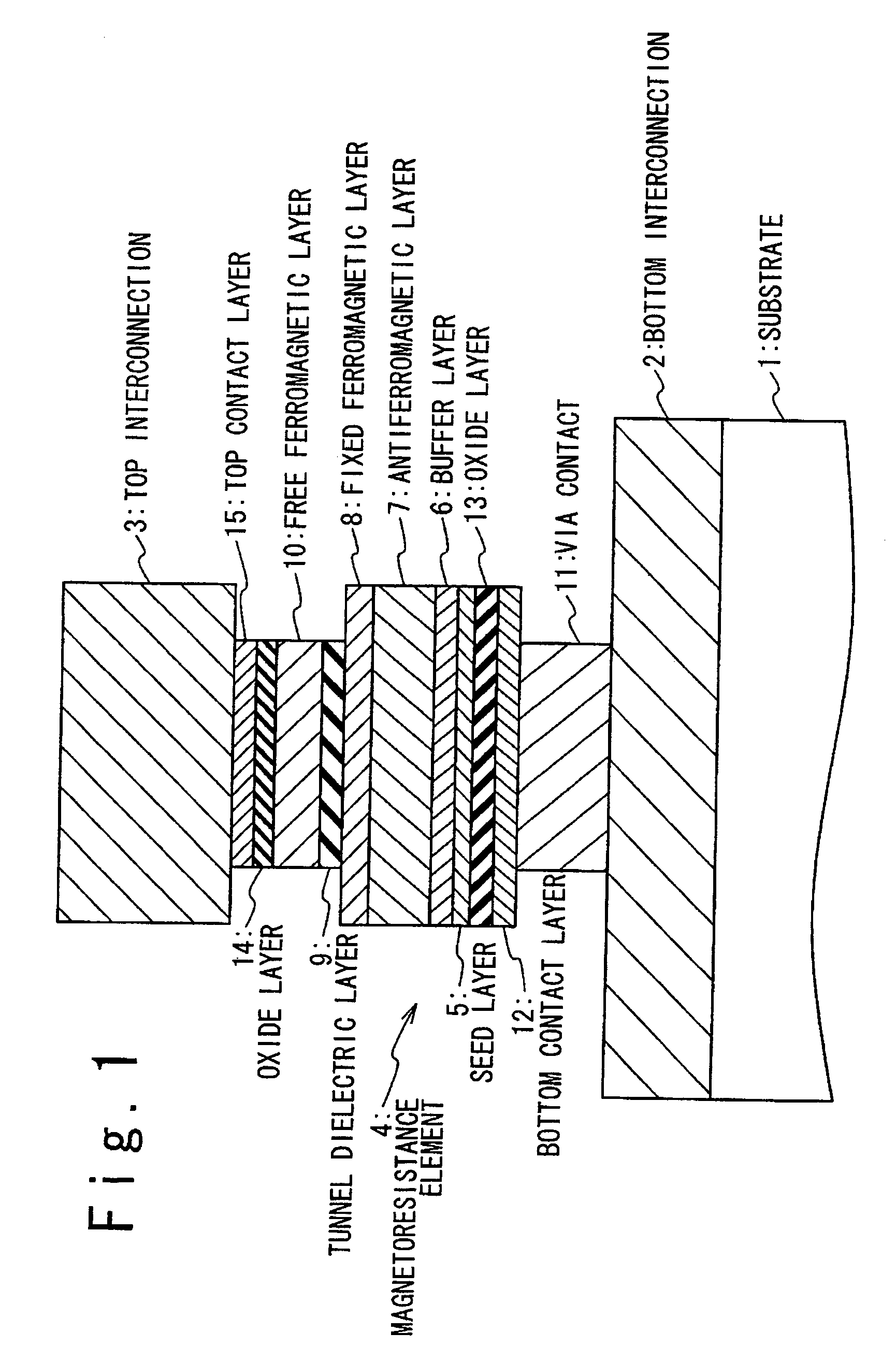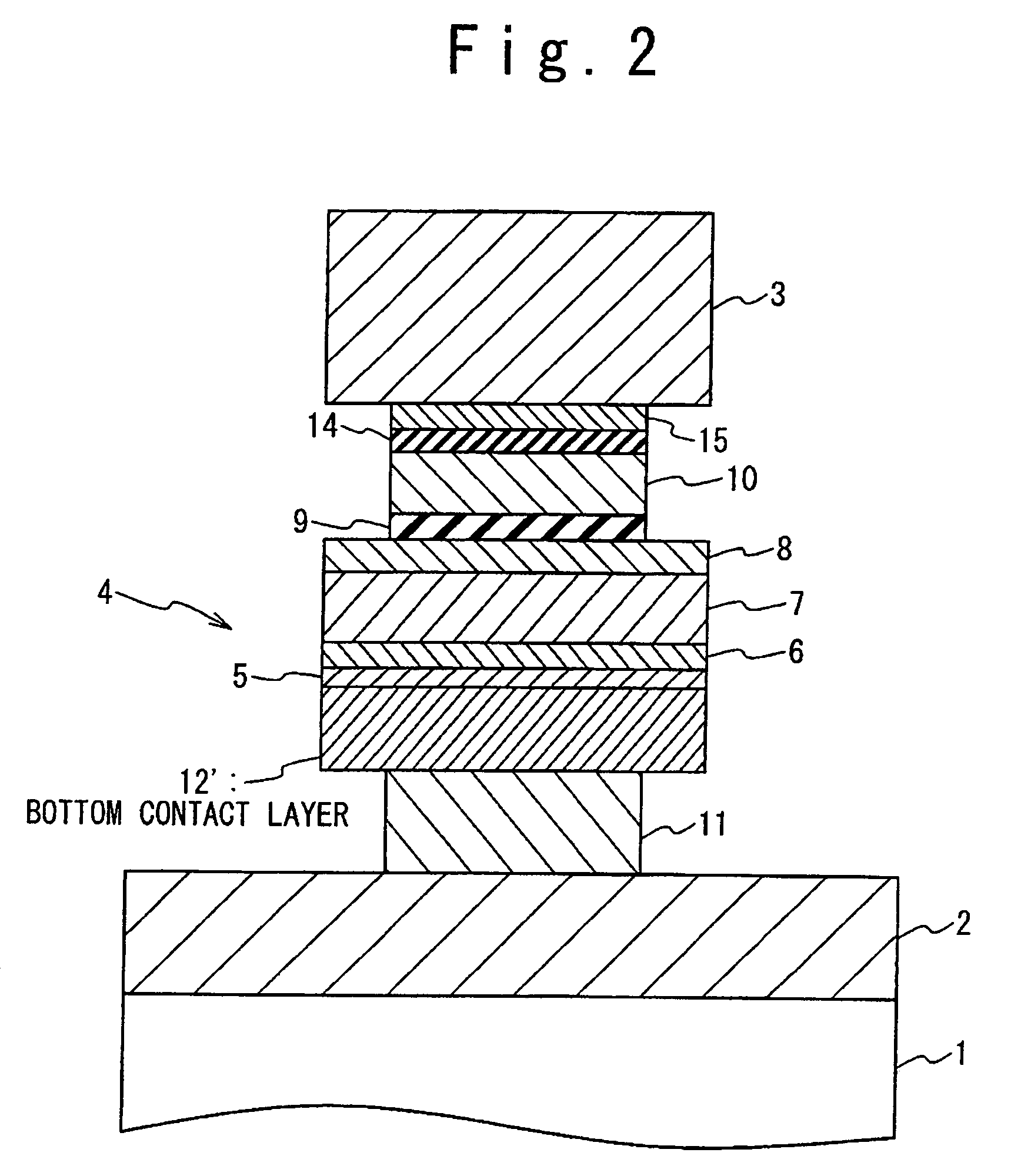Magnetoresistance device with a diffusion barrier between a conductor and a magnetoresistance element and method of fabricating the same
a magnetoresistance element and diffusion barrier technology, applied in the field of magnetoresistance devices and methods of fabricating the same, can solve the problems of thermal stability, interdiffusion between hard and soft ferromagnetic layers, reduction of coercive forces of free ferromagnetic layers, etc., and achieve the effect of improving the thermal stability of a magnetoresistance elemen
- Summary
- Abstract
- Description
- Claims
- Application Information
AI Technical Summary
Benefits of technology
Problems solved by technology
Method used
Image
Examples
example 1 (
The Present Invention)
substrate / Ta(3 nm) / AlCu(50 nm) / Ta(3 nm) / Al2O3(1 nm) / Ta(3 nm) / Ni81Fe19(3 nm) / IrMn(10 nm) / Co90Fe10(6 nm) / AlOx(2 nm) / Co90Fe10(2.5 nm) / Ni81Fe19(7.5 nm) / Al2O3(1 nm) / Ta(5 nm) / AlCu(300 nm)
[0188]Comparative Example 1 corresponds with the structure shown in FIG. 1 with the oxide layers 13 and 14 omitted. Example 1 corresponds with the structure shown in FIG. 1, having the oxide layers 13 and 14 formed with Al2O3 of 1 nm in thickness. The AlCu layer of 50 nm in thickness corresponds with the bottom interconnection 2, while the AlCu layer of 300 nm in thickness corresponds with the top interconnection 3.
[0189]FIG. 19 illustrates changes in MR ratios of Comparative Example 1 and Example 1 depending on the thermal treatment temperature. Comparative Example 1 experience reduction in the MR ratio after the thermal treatment at the temperatures over 300° C., while Example 1 is resistant to the thermal treatment at or below 300° C., and experiences minor reduction after the the...
example 2 (
The Present Invention)
substrate / Ta(3 nm) / AlCu(50 nm) / Ta(3 nm) / Al2O3(1 nm) / Ta(3 nm) / Ni81Fe19(3 nm) / IrMn(10 nm) / Co90Fe10(4 nm), and
example 3 (
The Present Invention)
substrate / Ta(3 nm) / AlCu(50 nm) / Ta(3 nm) / MgO(1 nm) / Ta(3 nm) / Ni81Fe19(3 nm) / IrMn(10 nm) / Co90Fe10(4 nm)
[0191]Comparative Example 2 corresponds with a portion of the structure of FIG. 1 between the tunnel dielectric layer 9 and the substrate 1 with the oxide layer 13 omitted. Example 2 corresponds a portion of the structure of FIG. 1 between the tunnel dielectric layer 9 and the substrate 1, having the oxide layer 13 formed with Al2O3 of 1 nm in thickness. Example 3 corresponds a portion of the structure of FIG. 1 between the tunnel dielectric layer 9 and the substrate 1, having the oxide layer 13 formed with MgO of 1 nm in thickness. For all the samples, the AlCu layers of 50 nm in thickness correspond with the bottom electrodes 2.
[0192]FIG. 20 illustrates changes in sheet resistances of the AlCu layers depending on the thermal treatment temperature obtained from Comparative Example 2 and Example 2. Comparative Example 2, which does not include the oxide layer 13,...
PUM
| Property | Measurement | Unit |
|---|---|---|
| thickness | aaaaa | aaaaa |
| thicknesses | aaaaa | aaaaa |
| thicknesses | aaaaa | aaaaa |
Abstract
Description
Claims
Application Information
 Login to View More
Login to View More - R&D
- Intellectual Property
- Life Sciences
- Materials
- Tech Scout
- Unparalleled Data Quality
- Higher Quality Content
- 60% Fewer Hallucinations
Browse by: Latest US Patents, China's latest patents, Technical Efficacy Thesaurus, Application Domain, Technology Topic, Popular Technical Reports.
© 2025 PatSnap. All rights reserved.Legal|Privacy policy|Modern Slavery Act Transparency Statement|Sitemap|About US| Contact US: help@patsnap.com



